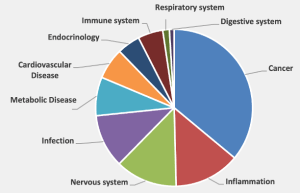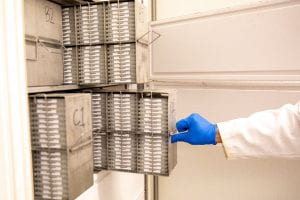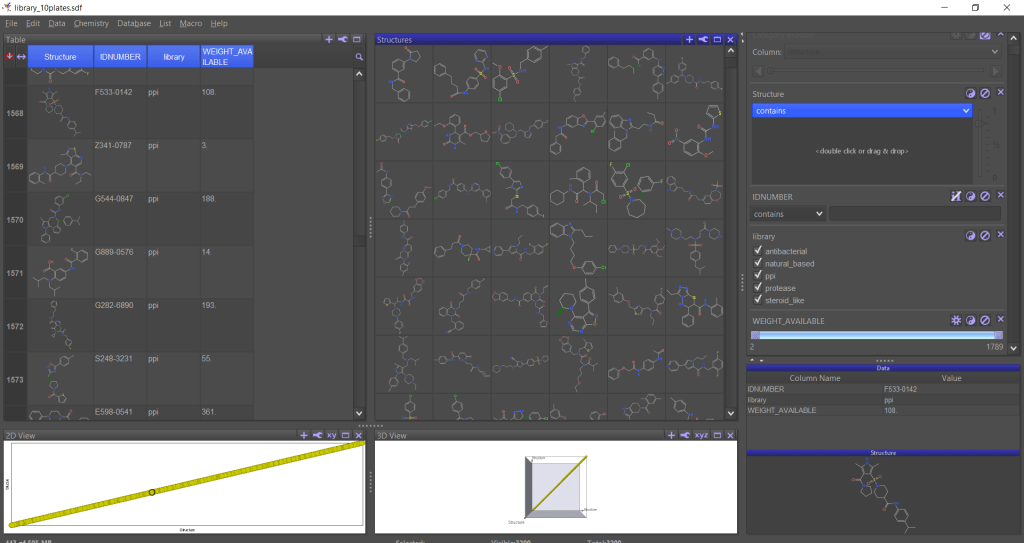List of compound libraries housed here:
NEW LIBRARIES ADDED IN 2022:
- 8,387 bioactives – TargetMol library
- known bioactives from TargetMol
- these are annotated with a characterized target or mechanism of action. It includes the FDA-approved collection and drugs for repurposing.
- For graphs depicting what all is in this library, look at the PDF here. For example, below is a graph showing the representation of different biomedical research area applications for the compounds in this library and another with the clinical status of the compounds.


- download a relatively simple list of all compounds in the TargetMol library
- download the same list with more complete annotations about the compounds
- download an SDF file with the compounds in the TargetMol library
- 3 unused daughter sets are located on our freezer bottom shelf, 27 Labcyte PP microplates in 384 well format (10 mM in 100% DMSO)
- the current active daughter set is in the deli fridge at the bottom right (2.5 mM in 90% DMSO/10% H2O).
- 64,000+ diversity compounds – ChemDiv library
- “preplated” synthetic and semi-synthetic diversity compounds from ChemDiv
- these have drug-like properties and are predicted to have a variety of activities. They cover many scaffolds and analogs around each scaffold.
- on our freezer bottom shelf, 200 Labcyte PP microplates in 384 well format – daughter plating in progress
- additional targeted diversity libraries are currently being assembled to include [note that this is on hold until more funds can be procured]:
- natural-product-like molecules
- steroid-like molecules
- predicted protease inhibitors
- predicted antibacterials
- predicted protein-protein-interaction modulators
- 762 fragments – Gardner library
- NMR-based fragment library from Kevin Gardner’s lab at CUNY
- Plated to Labcyte plates ready for Echo or pinning! in our freezer. Source vials are in the Partch lab -80.
- 20 mM stocks in DMSO
- Natural products
- new or expanded collections of botanical and microbial natural product extracts and fractions
- from the labs of John MacMillan, Laura Sanchez, and others
- actively being screened in various bioassays under way by the CSC staff and several researcher teams
- a goldmine for new pharmaceutical agents and tool compounds!
- >5,000 (and growing!) natural product-inspired cell-permeable cyclic peptides – Lokey
- DMSO stocks formatted in 384 well AB-GENE plates, reformatted from 96-well plates using the Janus MDT.
OLDER INVENTORY:
- 100,000 natural product extracts – NCI (received 2020)
- 23,000 diversity compounds – ChemDiv (purchased 2007 and 2013)
- 10,000 marine and terrestrial natural products – a unique growing collection from collaborations:
– John MacMillan, >11,000 bacterial natural product extract fractions with 1-10 (average of 5) compounds per fraction
– Phil Crews, >500 pure marine natural products
– Roger Linington
– and more! - 2,000 FDA-approved bioactives – SelleckChem (purchased ~2013) – click here for a list of all the compounds included and additional information on them.
- Enzo ICCD bioactives library (purchased ~2009)
- 1,000 known bioactives – Spectrum (purchased 2014)
- 500 fragments – Life Chemicals (purchased 2017)
- stocks of 200 mM in deuterated DMSO in 2 384-well plates AND 100 5-compound mixtures for NMR screening
- Here are complete plate maps in Excel for plate 1 and plate 2
- Here is the structural data file (SDF) with chemical information of all the compounds
- purchased for a collaboration between Carrie Partch, Nikolaos Sgourakis, Seth Rubin, and Scott Lokey for $8k ($16 per compound)
- here is a published review about NMR-based fragment library screening
- 400 natural product-inspired cell-permeable cyclic peptides – Lokey
About our libraries

We house a collection of commercially available compounds and a unique growing collection of marine and terrestrial natural products from collaborations. These libraries are available to any user of our equipment for the purpose of assays conducted in our center. We also allow users to cherry pick a few compounds of interest for follow-up assays. We charge a fee for use of a library or for 1ul of a compound. Unless otherwise noted, our libraries are currently at 10 mM in 100% DMSO and stored either in -20 degrees (click for -20 inventory) or in a room temperature desiccator. They are heat-sealed with foil covering to prevent moisture from entering or compound cross-contamination. We have accumulated a reference database of results collected for our compounds in a variety of assays, including cytotoxicity data in a variety of cells (microbial and mammalian) and cytological profiling for guilt-by-association mechanism of action identification of a novel compound.
Structural information of chemical libraries are often created in structural data file (SDF) format.
- Here is a description of what SDF files are and a list of software that open them. On the Life Chemicals website.
- Here you can find a comparison of the various software available, made at UC Santa Barbara.
- Here is a 13-page PDF from the NIH to guide you in working with SDF files
- Here is the download link for Data Warrior, the software used by Beverley to view SDF files. Below is a screenshot of what the software looks like, with our newest ChemDiv focused libraries showing.
